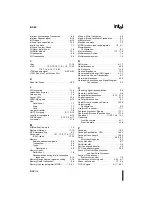
A-21
SIGNALS REFERENCE
•
The response agent returns a Normal without data response for a write transaction with
HITM# and DEFER# deasserted in the Snoop Phase, when the addressed agent samples
TRDY# active and DBSY# inactive, and it is ready to complete the transaction.
•
The response agent must return an Implicit writeback response in the next clock for a read
transaction with HITM# asserted in the Snoop Phase, when the addressed agent samples
TRDY# active and DBSY# inactive.
•
The addressed agent must return an Implicit writeback response in the clock after the
following sequence is sampled for a write transaction with HITM# asserted:
— TRDY# active and DBSY# inactive
— followed by TRDY# inactive
— followed by TRDY# active and DBSY# inactive
•
The defer agent can return a Deferred, Retry, or Split response anytime for a read
transaction with HITM# deasserted and DEFER# asserted.
•
The defer agent can return a Deferred or Retry response when it samples TRDY# active
and DBSY# inactive for a write transaction with HITM# deasserted and DEFER# asserted.
A.1.46. RSP# (I)
The RSP# signal is the Response Parity signal. It is driven by the response agent during assertion
of RS[2:0]#. RSP# provides parity protection for RS[2:0]#.
A correct parity signal is high if an even number of covered signals are low and low if an odd
number of covered signals are low. During Idle state of RS[2:0]# (RS[2:0]#=000), RSP# is also
high since it is not driven by any agent guaranteeing correct parity.
Pentium Pro processor bus agents can check RSP# at all times and if a parity error is observed,
treat it as a protocol violation error. If the BINIT# driver is enabled during configuration, the
agent observing RSP# parity error can assert BINIT#.
A.1.47. SMI# (I)
System Management Interrupt is asserted asynchronously by system logic. On accepting a Sys-
tem Management Interrupt, the Pentium Pro processor saves the current state and enters SMM
mode. It issues an SMI Acknowledge Bus transaction and then begins program execution from
the SMM handler.
A.1.48. SMMEM# (I/O)
The SMMEM# signal is the System Management Mode Memory signal. It is driven on the sec-
ond clock of the Request Phase on the EXF4#/Ab7# signal. It is asserted by the Pentium Pro
processor to indicate that the processor is in System Management Mode and is executing out of
SMRAM space.
Summary of Contents for Pentium Pro Family
Page 17: ...1 Component Introduction ...
Page 26: ...2 Pentium Pro Processor Architecture Overview ...
Page 27: ......
Page 36: ...3 Bus Overview ...
Page 62: ...4 Bus Protocol ...
Page 105: ...5 Bus Transactions and Operations ...
Page 126: ...6 Range Registers ...
Page 131: ...7 Cache Protocol ...
Page 135: ...8 Data Integrity ...
Page 148: ...9 Configuration ...
Page 161: ...10 Pentium Pro Processor Test Access Port TAP ...
Page 172: ...11 Electrical Specifications ...
Page 201: ...12 GTL Interface Specification ...
Page 229: ...13 3 3V Tolerant Signal Quality Specifications ...
Page 233: ...14 Thermal Specifications ...
Page 239: ...15 Mechanical Specifications ...
Page 241: ...15 2 MECHANICAL SPECIFICATIONS s Figure 15 1 Package Dimensions Bottom View ...
Page 252: ...16 Tools ...
Page 260: ...16 8 TOOLS Figure 16 4 Generic MP System Layout for Debug Port Connection ...
Page 264: ...17 OverDrive Processor Socket Specification ...
Page 290: ...A Signals Reference ...
Page 320: ...Index ...
Page 328: ......
















































